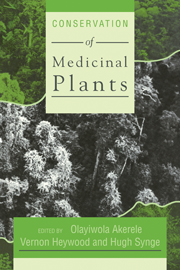Book contents
- Frontmatter
- Contents
- Contributors
- Preface
- Acknowledgements
- The Chiang Mai Declaration
- Introduction
- 1 Medicinal Plants: Policies and Priorities
- 2 The Joint IUCN-WWF Plants Conservation Programme and its Interest in Medicinal Plants
- The Issue of Medicinal Plants
- Science, Industry and Medicinal Plants
- Techniques to Conserve Medicinal Plants
- Policies to Conserve Medicinal Plants
- Experiences from Programmes to Conserve Medicinal Plants
1 - Medicinal Plants: Policies and Priorities
Published online by Cambridge University Press: 07 September 2010
- Frontmatter
- Contents
- Contributors
- Preface
- Acknowledgements
- The Chiang Mai Declaration
- Introduction
- 1 Medicinal Plants: Policies and Priorities
- 2 The Joint IUCN-WWF Plants Conservation Programme and its Interest in Medicinal Plants
- The Issue of Medicinal Plants
- Science, Industry and Medicinal Plants
- Techniques to Conserve Medicinal Plants
- Policies to Conserve Medicinal Plants
- Experiences from Programmes to Conserve Medicinal Plants
Summary
Traditional medicine has been with the World Health Organization (WHO) for the last twelve years or so and for the rest of the world for the last several thousand years of recorded history. One might say that we are new at the game.
Traditional medicine is widespread throughout the world. It comprises those practices based on beliefs that were in existence, often for hundreds of years, before the development and spread of modern scientific medicine and which are still in use today. As its name implies, it is part of the tradition of each country and employs practices that have been handed down from generation to generation. Its acceptance by a population is largely conditioned by cultural factors and much of traditional medicine, therefore, may not be easily transferable from one culture to another. In dealing with traditional medicine, WHO aims at exploiting those aspects of it that provide safe and effective remedies for use in primary health care.
Acknowledging its potential value for the expansion of health services, the World Health Assembly has passed a number of resolutions. In 1976, it drew attention to the manpower reserve constituted by traditional practitioners (resolution WHA29.72). In 1977, it urged countries to utilize their traditional systems of medicine (resolution WHA30.49). In 1978, it called for a comprehensive approach to the subject of medicinal plants (resolution WHA 331.33.) This approach was to include:
An inventory and therapeutic classification, periodically updated, of medicinal plants used in different countries;
Scientific criteria and methods for assessing the safety of medicinal plant products and their efficacy in the treatment of specific conditions and diseases;
International standards and specifications for identity, purity, strength and manufacturing practices;
[…]
- Type
- Chapter
- Information
- Conservation of Medicinal Plants , pp. 3 - 12Publisher: Cambridge University PressPrint publication year: 1991
- 2
- Cited by



